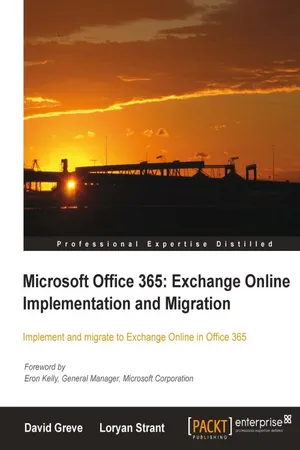
Microsoft Office 365: Exchange Online Implementation and Migration
- 268 pages
- English
- ePUB (mobile friendly)
- Available on iOS & Android
Microsoft Office 365: Exchange Online Implementation and Migration
About This Book
In Detail
Microsoft Office 365 brings together cloud versions of the most trusted communications and collaboration products in a single desktop suite for businesses of all sizes. Microsoft Exchange Online gives you access to enterprise class email, calendar, and contacts from virtually anywhere, at any time, on desktops, laptops, tablets, and mobile devices.
"Microsoft Office 365: Exchange Online Implementation and Migration" is a practical hands-on tutorial that shows small businesses to enterprises how to implement and migrate to Exchange Online in Office 365. This book also places an emphasis on setting up a Hybrid and migrating from Exchange on-premise to Exchange Online.
"Microsoft Office 365: Exchange Online Implementation and Migration" will show small businesses to enterprises the steps to implement and migrate to Exchange Online in Office 365. The book starts by providing an overview of the Office 365 plans available and how to make a decision on what plan fits your organization. The book then dives into topics such as the Office 365 Admin Portal, integration options for professionals and small businesses, integration options for enterprises, preparing for a simple migration, performing a simple migration, and preparing for a hybrid deployment and migration amongst others.
Approach
A practical, hands-on tutorial that shows small businesses to enterprises how to implement and migrate to Exchange Online in Office 365.
Who this book is for
If you are an information technology (IT) professional; administrator, small business owner, manager or consultant who needs to implement and migrate to Exchange Online in Office 365 within your business, then this book is for you. Knowledge of Microsoft Office 365 is not required, however, experience with Microsoft Exchange Server and mail clients, role and delegation concept is required.
Frequently asked questions
Information
Microsoft Office 365: Exchange Online Implementation and Migration
Table of Contents
Table of contents
- Microsoft Office 365: Exchange Online Implementation and Migration